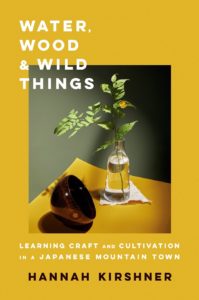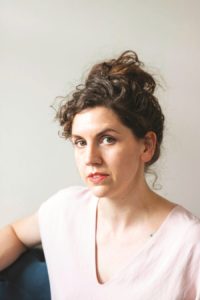Until the Meiji Restoration in 1868, the Japanese government made it difficult for outsiders to explore the country. Even with rapid industrialization and modernization, Japan remained a hard place for Westerners to know until well into the 20th century, partly because of language. Though the barriers have largely fallen, Westerners who wish to immerse themselves and report back still run the risk of describing the Japanese as essentially different and unknowable.
American artist and chef Hannah Kirshner takes on these themes in her quietly compelling book, Water, Wood, and Wild Things: Learning Craft and Cultivation in a Japanese Mountain Town. Published in March by Viking, the book documents Kirshner’s four-year exploration of Yamanaka, a town three hours by train west of Tokyo, with a population of only 8,000.
Water, Wood, and Wild Things is memoir, ethnography, cookbook, and sketchbook rolled into one. It evokes the best of the nature writing of Rachel Carson and Wendell Berry, as well as the food writing of M.F.K. Fisher and craft writing of Edmund de Waal.

Kirshner’s approach allows her, she writes, “to observe things that haven’t been written about extensively — or at all — in English, and are little known or taken for granted in Japan. Even in our hyperconnected world, there are still places you can’t find on the internet.”
With these observations, Kirshner largely avoids the trap of exoticizing, into which many previous Westerners have fallen. It’s not just Americans who don’t know about the ways of life that she’s documenting. The Japanese themselves, she underscores, are no more likely to be considered insiders. Young people leave places like Yamanaka for education or employment in bigger cities, and they never return. They aren’t interested in (or can’t afford) learning what it takes to maintain a communal bath or to preserve a pond to support waterfowl.
Kirshner, now in her 30s, became preoccupied by Japan in her early 20s, when she first visited because of her interest in Japanese art and food. She considered returning to teach English, as many young people do, but concluded that she wasn’t a born language teacher. Years later, a miscommunication led a Japanese friend of a friend to stay in her apartment in Brooklyn. This guest then invited her to work in his saké bar in Yamanaka. The initial two-month stint turned into a love affair with the small town.
A world away from the neon lights and bustle of Tokyo, Yamanaka is home to traditional crafts such as wood turning and charcoal making. Its surrounding forests and farms support sustainable back-to-the-land hunting and harvesting, which fascinates Kirshner. She divides the book into four sections —“Water,” “Wood,” “Wild Things,” and “Cultivation” — and ends each chapter with a recipe. The dishes range from ramen Bolognese, with a sauce made from wild boar that she helped to kill and butcher, to an adzuki jam and butter sandwich, the beans for which she grew in her own kitchen plot.
A graduate of Rhode Island School of Design, Kirshner knows how hard it is to make things, though she isn’t afraid to try. Her observations about her teachers’ works render extraordinary what at first glance might seem ordinary. Her drawings are charming, and her words, miraculous — made even more so by an end-of-the-book acknowledgement that grade-school teachers advised her parents that she’d never learn to read.

Kirshner’s description of a wooden saké cup is but one example of her gorgeous writing: “A whorl of wood grain glimmered like a panther’s eye through the translucent black finish, different from the opaque coating of black or red that makes most Japanese lacquerware nearly indistinguishable from plastic. The lip was so thin it seemed I could crush the cup in my hand, and yet it felt strong. … Admiring the pleasing tension in its lines, I marveled that a cup could make me feel something more intense and complex than appreciation for its beauty.”
Kirshner is quick to describe herself as an obvious outsider in Yamanaka. An athletic woman traveling on her own, she sometimes attracts uncomfortable attention. In early chapters of the book, she wonders if she will ever tame her clumsy Western body to move gracefully during a Japanese tea ceremony or folk dance. Her curiosity leads her to try her hand at pursuits the Japanese have gendered as male, from saké making to duck hunting.
At first, Kirshner is content to be an outsider. “My nature,” she writes, “is to dive deep into something for a time — roller derby, bicycle racing, pastry baking, cocktail bartending — until I feel as though I understand it enough.” As she moves from place to place, pursuit to pursuit, she’s repeatedly rendered an amateur. She doesn’t believe she has the focus to drill down for “decades or years … to become competent, if not truly skilled” at any one craft.
But this changes in “Wild Things,” the third section of the book. Kirshner persuades experts to teach her how to hunt and forage, grow rice the traditional way, and raise vegetables organically. She develops a deep kinship with these teachers and their way of life. These chapters also explore Kirshner’s childhood, adding richness and depth to the memoir. Kirshner writes that she experienced a profound dislocation when her parents divorced, forcing her to move, with her mother, from the family farm to the city.
Hands in the soil on the outskirts of Yamanaka, Kirshner at last feels at home. She plans to buy an abandoned house and put down roots in its garden. Though she realizes that “fitting in” is not “her thing,” she somehow fits in and belongs to Yamanaka. It is there, one of her teachers observes, that “there are lots of strange people. Like me and you, Hannah-chan.”
Editor’s Note: An earlier version of this article incorrectly stated the population of Yamanaka and the number of sections of Kirshner’s book.
